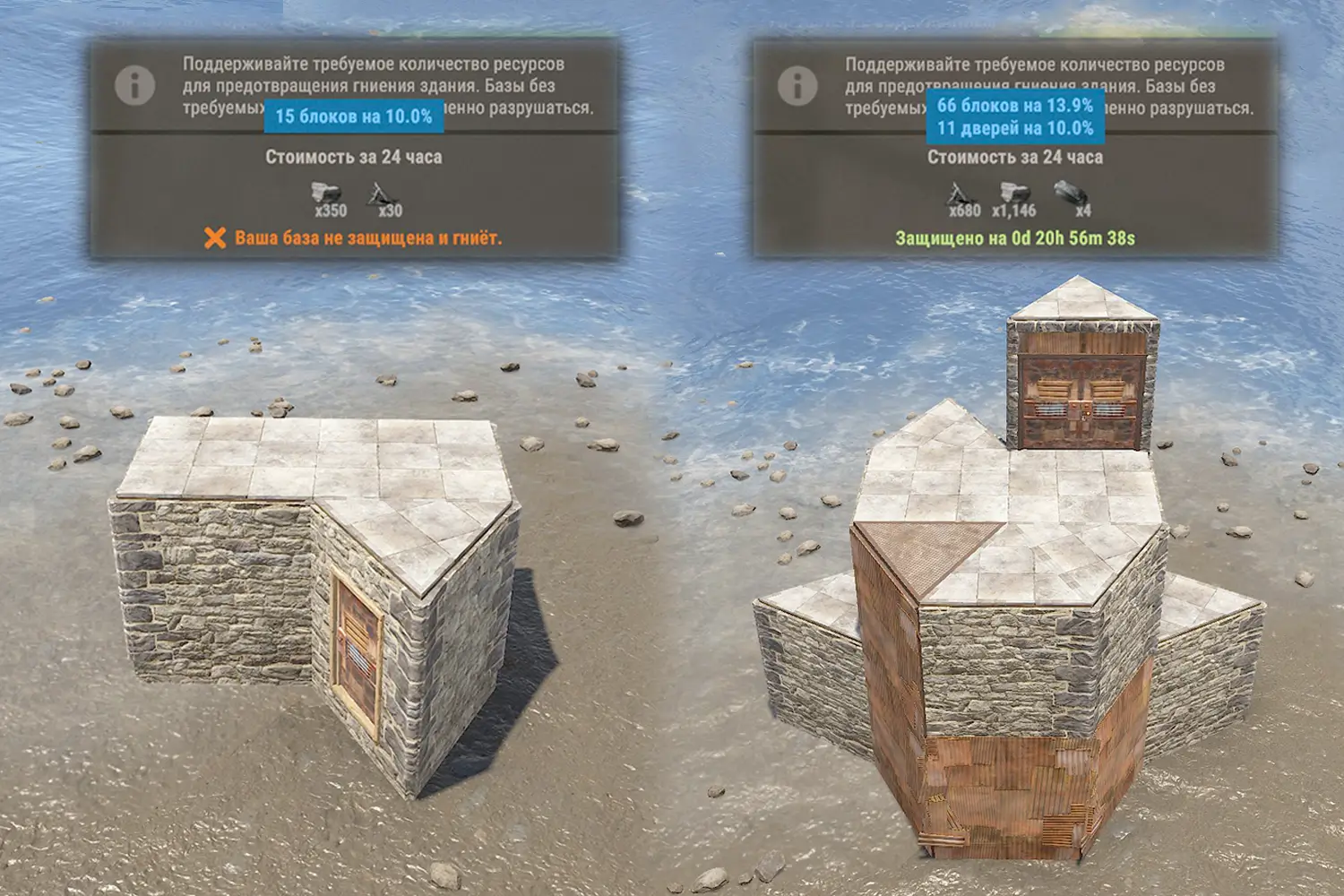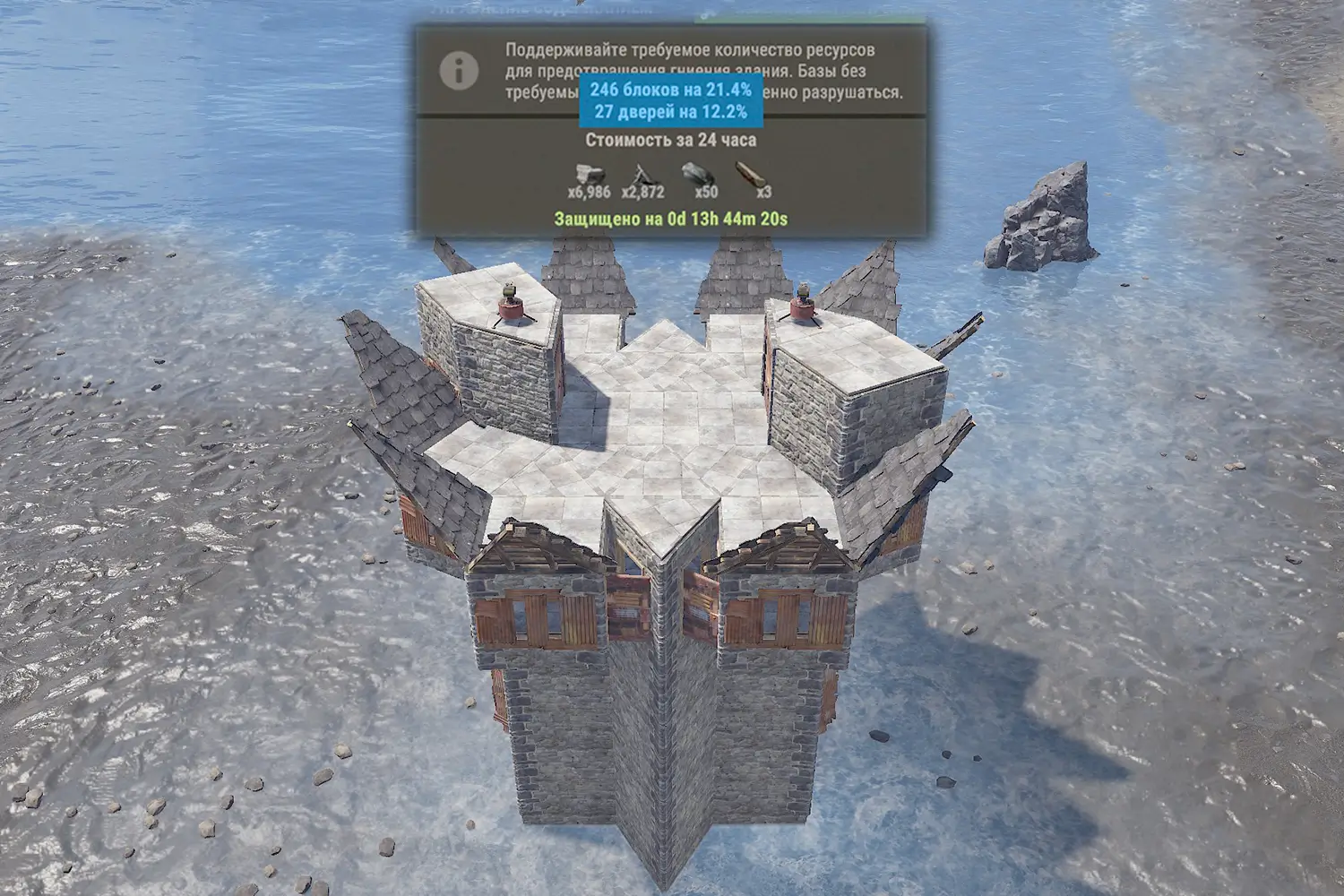Anyone who’s played Rust knows the feeling—you log in after some sleep and all that’s left of your base are sleeping bags. The reason is almost always the same: you ran out of upkeep.
The upkeep system is part of the game’s economy that determines how long structures survive. Every building piece has an upkeep cost, and those resources are automatically drained from the tool cupboard. When the stock runs dry, your base starts to decay—from the outside in, starting with the weakest materials.
In this guide we’ll break down what makes up the upkeep cost, how decay works, how long repairs take, and how to cut expenses so your base doesn’t vanish after a single night offline.
Base Upkeep
Upkeep is the daily resource drain that prevents your structure from decaying. Each building piece consumes some of the material it’s made of.
The higher the tier, the more resources it needs. Stone costs more than wood. Metal costs more than stone. Armored costs the most.
Progressive Scaling
Base size directly affects consumption. The more connected pieces you have, the higher the upkeep percentage.
This system prevents massive, heavily fortified bases from existing without ongoing costs and keeps size and spending in balance.
Two Separate Buckets
The game calculates building pieces and doors as two independent groups.
Their percentages are calculated separately and don’t add together.
Example:
A base has 68 building pieces with a 14% rate and 11 doors with a 10% rate.
Each group consumes resources at its own percentage, independently.
This approach reduces the impact of doors on the total upkeep and makes the calculation more accurate.
What Counts Toward Upkeep
All construction elements count: foundations, walls, floors, roofs, frames, doors, and hatches.
Sleeping bags, boxes, furnaces, workbenches, turrets, and similar deployables do not affect upkeep.
External walls don’t increase upkeep, but they will decay if they fall outside your TC radius.
How to See Your Piece Count
You don’t need to count pieces manually—the game does it for you. Just look at your tool cupboard and hover the text “24-hour upkeep cost.”
Example Piece Counts
Using a standard 1×2 for solo/duo as an example, you can see how the piece count ramps up.

The bare minimum—about 15 pieces and \~10% consumption—is basically a starter with a buffer room and nothing else.
Add a second floor, a couple more buffers, and roof access and it goes up, but not by much—the base still consumes relatively little.

Once you stack more floors, shooting floors, extra buffers, and upgrade the core to HQM, upkeep jumps significantly.
Tool Cupboard Radius
The TC protects everything in its radius. If you have enough resources, the base stays intact.
If structures don’t share foundations, they’re treated as separate buildings. Each needs its own TC and its own resource stock.
What Happens When You Run Out?
When the TC runs out of a material, the base begins to decay. Decay is gradual destruction that moves from the outside in.
Only the parts lacking materials will decay. If you’re out of stone, only stone pieces decay. No metal—only metal decays. Other pieces remain intact.
Decay Speed
Each material has a fixed time to fully disappear: wood — 3 hours, stone — 5 hours, metal — 8 hours, armored — 12 hours.
Pieces lose health evenly until they’re gone. Outer walls and floors go first, then the interior.
Decay Ticks
Decay happens in cycles every 10 minutes. Each tick removes a chunk of health depending on material:
- Wood — 14 HP per tick
- Stone — 17 HP per tick
- Metal — 16 HP per tick
- Armored — 14 HP per tick
Repair Cost
Damaged structures auto-repair if the TC holds the required materials. The repair rate matches the decay rate and does **not** consume extra resources.
That means you can save mats: if your base is only slightly decayed or was lightly damaged, you don’t have to hammer-repair and spend resources—the base will heal itself over time.
Important: Protection After the TC Is Destroyed
Protection on
If the TC is destroyed, the base “absorbs” 24 hours of upkeep and pauses decay so the structure doesn’t collapse immediately after a raid.
Protection off
Protection turns off as soon as a new TC is placed inside. Decay cycles resume.
How to prevent it from being turned off
Don’t let offline raiders place a new TC. Place extra cupboards whose radii overlap with your main TC. That way raiders can’t claim build privilege or disable the decay protection.
How to Reduce Upkeep
1. Build compact
Every connected piece raises the overall upkeep percentage. The more footprint and surface, the higher the rate. A compact layout with minimal “nice-to-haves” lowers costs.
2. Segment structures
If your base comprises independent sections, it’s often cheaper to separate foundations and give each its own TC. Each section is then calculated as a smaller structure with a lower percentage.
3. Use materials smartly
Don’t upgrade everything. Make the core metal or HQM, but keep adjacent buffer walls—those that don’t raise raid cost—in stone. You’ll cut upkeep without losing strength in critical spots.
4. Forget old myths
It used to be said that exterior pieces cost more upkeep than interior ones. That’s outdated. Today, each piece consumes the same amount regardless of placement. Total cost depends only on material type and overall structure size.
🎮Base maintenance? Check. Profit growth? Check. Cobalt Lab




